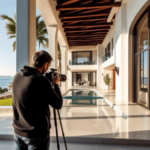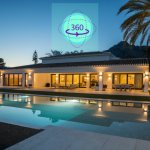How Will Real Estate Photography Transform in 2025?
In a world where visual impressions are crucial, the importance of real estate photography is becoming increasingly apparent. With the right cameras, lenses and lighting conditions, photographers can create stunning photos of properties that captivate potential buyers. But how will the landscape of property photography evolve in 2025? The answer could lie in the integration of innovative marketing solutions and virtual tours that help take property presentation to a new level.
1. Introduction: The Future of Real Estate Photography
As real estate photography evolves, the need for photographers to embrace innovative technology becomes increasingly vital. In 2025, the best images will combine advanced equipment with creative lighting techniques to showcase properties in their finest light. A skilled photographer will understand how to leverage the latest camera lenses to capture stunning views from various angles, enhancing property listings like never before. This evolution will not only improve the visual appeal of real estate photos but also provide time-saving benefits through more efficient video capabilities and virtual tours. Marketing strategies will shift towards these immersive experiences, allowing potential buyers to engage with listings on a deeper level. With the integration of aerial photography and cutting-edge imaging techniques, capturing the essence of a property will help set listings apart in a competitive market. As these technologies continue to advance, professional real estate photographers will play a key role in crafting compelling narratives that draw clients in and drive successful sales.
2. Emerging Technologies in Real Estate Photography
As we look towards 2025, the evolution of real estate photography will be profoundly influenced by emerging technologies. Photographers will need to harness the best advancements in camera and lens technology to capture properties in ways that truly showcase their potential. With the advent of intelligent lighting systems, capturing the perfect light will become simpler, ensuring each photo is vibrant and inviting. Virtual reality will enable prospective buyers to immerse themselves in properties before setting foot inside, fundamentally changing the marketing landscape. Meanwhile, high-quality video will play a crucial role in providing dynamic views of homes, allowing clients to experience space in real time. Aerial photography will also gain prominence as drone capabilities expand, offering unique perspectives that enhance property listings. By integrating these technologies, real estate photographers can create captivating visual content that not only showcases the essence of each property but also meets the evolving demands of clients and buyers alike.
3. The Role of Virtual Reality in Real Estate Photography
Virtual reality is set to revolutionise real estate photography, offering a dynamic approach to property marketing that transcends traditional methods. By integrating immersive experiences, potential buyers can engage with properties in a way that photographs alone cannot achieve. This technology allows for virtual walkthroughs, enabling clients to explore every corner without having to physically visit, saving time and enhancing their decision-making process. The best photographers will harness advanced cameras and specialised lenses to capture stunning visuals that, combined with virtual reality, create a realistic depiction of the space. Lighting becomes pivotal; expertly lit photos paired with virtual elements can truly bring a property to life. As this trend evolves, real estate professionals will require photographers who not only possess technical skills but also a deep understanding of marketing strategies. Investing in virtual reality solutions will empower your listings, making them stand out in a competitive market while effectively meeting the needs of discerning buyers seeking genuine insights into their future homes.4. Enhancing Property Listings with Aerial Photography
Aerial photography is set to revolutionise real estate listings by providing stunning, bird’s-eye views that allow potential buyers to appreciate properties in their entirety. By utilising high-quality cameras and advanced lenses, photographers can capture the unique features of each estate, showcasing not just the property but also its surroundings. Lighting plays a crucial role; optimal conditions can dramatically enhance the appeal of images, making them more inviting. As video technology advances, integrating aerial footage with virtual tours will create immersive experiences thatengage viewers in real time, helping them envision living in the space. These innovative marketing strategies are no longer optional; they are a necessity for those looking to stand out in a competitive market. As demand grows, professional photographers skilled in aerial techniques will become invaluable partners for real estate agents. This approach not only highlights properties effectively but also conveys a commitment to quality that prospective clients will appreciate.
5. The Impact of 360-Degree Imaging on Real Estate Photography
The impact of 360-degree imaging on real estate photography is poised to redefine how potential buyers engage with properties. By providing immersive views, this technology allows clients to explore every corner of a home, making them feel as though they are physically present. The best cameras equipped with advanced lenses can capture stunning photos in optimal lighting conditions, showcasing properties in their full glory. In today’s competitive market, real estate professionals need to leverage these capabilities to enhance their marketing efforts. With virtual tours combining both high-quality images and real-time video, prospective buyers can get a comprehensive view of the estate without stepping foot inside. This not only streamlines the decision-making process but also builds trust, as clients can appreciate the property’s true essence. As this technology continues to evolve, the role of skilled photographers becomes increasingly vital in crafting captivating visuals that resonate with buyers, ensuring that listings stand out amidst the abundance of options available.
6. Trends in Post-Production Techniques for Real Estate Photography
As we look toward 2025, post-production techniques in real estate photography are set to evolve significantly. The best photographers will increasingly rely on advanced software tools to enhance their images, ensuring properties stand out in a competitive market. With the right camera and lens, high-quality initial shots can be transformed into even more striking visuals through careful editing. Lighting plays a critical role; clever adjustments can bring warmth and vibrancy to spaces, making them more appealing to potential buyers. Moreover, the integration of video elements is becoming commonplace, allowing for dynamic presentations that capture the essence of each property in real time. Marketing strategies will also adapt, utilising these enhanced photos and videos to engage clients effectively. By investing in innovative post-production techniques, real estate professionals will not only elevate their listings but also meet the growing expectation for stunning imagery that showcases properties in their best light.
7. The Importance of Professionalism in Real Estate Photography
In the realm of real estate photography, professionalism plays a pivotal role in shaping perceptions and outcomes. As the market evolves, clients increasingly seek photographers who not only possess technical skills but also embody reliability and integrity. A proficient photographer understands the nuances of lighting and composition, utilising the best camera equipment and lenses to capture stunning images that truly represent the property. Moreover, they appreciate the significance of post-production techniques that enhance visual appeal while maintaining authenticity. This dedication to quality reassures clients and helps properties stand out in a saturated market. With the advent of innovative marketing strategies, such as virtual tours and video presentations, a professional approach becomes even more crucial. It ensures that every photo serves a purpose, inviting potential buyers to engage with listings on a deeper level. Ultimately, professionalism in real estate photography not only elevates individual listings but also fosters trust and long-term relationships in an industry driven by reputation.
8. Conclusion: Embracing Change in Real Estate Photography for 2025
As we look towards 2025, real estate photography is set to undergo significant transformation driven by advancements in technology. The best photographers will leverage innovative cameras and lenses to capture properties in a way that highlights their true essence. Enhanced lighting techniques will play a pivotal role, allowing for stunning visuals that draw potential buyers in. In this evolving landscape, marketing strategies will increasingly require high-quality photos and videos that provide immersive views of listings. Virtual tours will become essential, giving clients real-time access to properties from the comfort of their own homes. As the demand for compelling imagery rises, professional photographers must adapt their skills to incorporate new tools and methods, ensuring they meet the evolving needs of the market. By embracing these changes, they can help redefine how properties are showcased and marketed, ultimately leading to more successful sales and satisfied clients.
People also ask
How much do estate agent photographers charge?
The cost of estate agent photographers can vary significantly based on several factors, including location, experience, and the services provided. Generally, you can expect to pay anywhere from 100€ to 500€ for a standard property shoot. For smaller properties, such as flats or one-bedroom apartments, fees may start at around 100€ to 200€. Larger homes, particularly those in high-end markets, can command prices upwards of €300 to 500€. In addition to basic photography, many photographers offer packages that include additional services such as drone photography, virtual tours, and professional editing. These extras can increase the total cost, often adding €50 to €200 to the initial price. It’s also important to consider the photographer’s experience and reputation. Established professionals with a strong portfolio may charge more but often deliver higher-quality results that can significantly enhance a property’s appeal. Ultimately, it’s wise for estate agents to weigh the potential return on investment when choosing a photographer, as high-quality images can lead to quicker sales and potentially higher offers. Investing in professional photography is often seen as a crucial step in effective property marketing.
Do estate agents use photographers?
Estate agents frequently rely on photographers to enhance their property listings and marketing efforts. High-quality photography plays a crucial role in attracting potential buyers, as visuals are often the first impression a property makes. Professional photographers have the skills and equipment to showcase a property’s best features, using techniques such as proper lighting, angles, and composition to create striking images that highlight the space effectively. In addition to standard photographs, many estate agents also utilise specialised services like drone photography and virtual tours, which provide unique perspectives and immersive experiences for prospective buyers. These innovative solutions help to differentiate listings in a competitive market, making properties more appealing. Moreover, the use of professional imagery can significantly impact the speed and price at which a property sells. Listings with high-quality photos tend to receive more views and inquiries, leading to quicker sales and potentially higher offers. This reliance on professional photography underscores its importance in the real estate industry, as it helps estate agents present properties in the best light possible, ultimately contributing to their success and reputation in the market.
How to do a 3D photo for real estate?
Creating a 3D photo for real estate involves several steps to ensure a captivating and accurate representation of the property. First, select a high-quality camera capable of capturing detailed images, preferably one with a wide-angle lens to encompass more of the space in a single shot. Begin by planning your shots; consider the best angles that highlight the property’s features, such as spacious living areas, unique architectural details, and outdoor spaces. Ensure the property is well-lit, either through natural light or by using additional lighting equipment to eliminate shadows and enhance colours. Next, take multiple images from different angles, focusing on key areas such as kitchens, bathrooms, and living rooms. After capturing the images, use specialised software to stitch them together into a 3D model. This software typically allows for adjustments in perspective, lighting, and texture to create a realistic representation of the space. Finally, export the 3D photo in a suitable format for online listings or virtual tours. Incorporating interactive elements, such as clickable hotspots that provide additional information, can further enhance the viewer’s experience and engagement with the property.
Can I use 24mm for real estate?
Using a 24mm lens for real estate photography can be highly beneficial, particularly for capturing the essence of a space. This focal length is ideal for wide-angle shots, allowing photographers to showcase larger rooms and make spaces appear more expansive. The 24mm lens helps to capture more of the environment in a single frame, which is crucial when highlighting the layout and flow of a property. When using a 24mm lens, it’s essential to be mindful of perspective distortion, which can occur when photographing interiors. While this lens is excellent for wide shots, it can exaggerate the size of objects closer to the lens, leading to an unrealistic representation of the space. To mitigate this, ensure that the camera is positioned at a proper height and distance. In addition to interior shots, a 24mm lens is also effective for exterior photography, where it can capture the entire façade of a property, providing context within its surroundings. Overall, when used thoughtfully, a 24mm lens can enhance real estate photography by delivering clear, engaging images that attract potential buyers.
Please see examples of our work on our portfolio page
And more information about our services here
More Information
- https://www.format.com/magazine/resources/photography/real-estate-photography
- https://www.photoplan.co.uk/property-photography-2/
- https://www.reddit.com/r/RealEstatePhotography/



